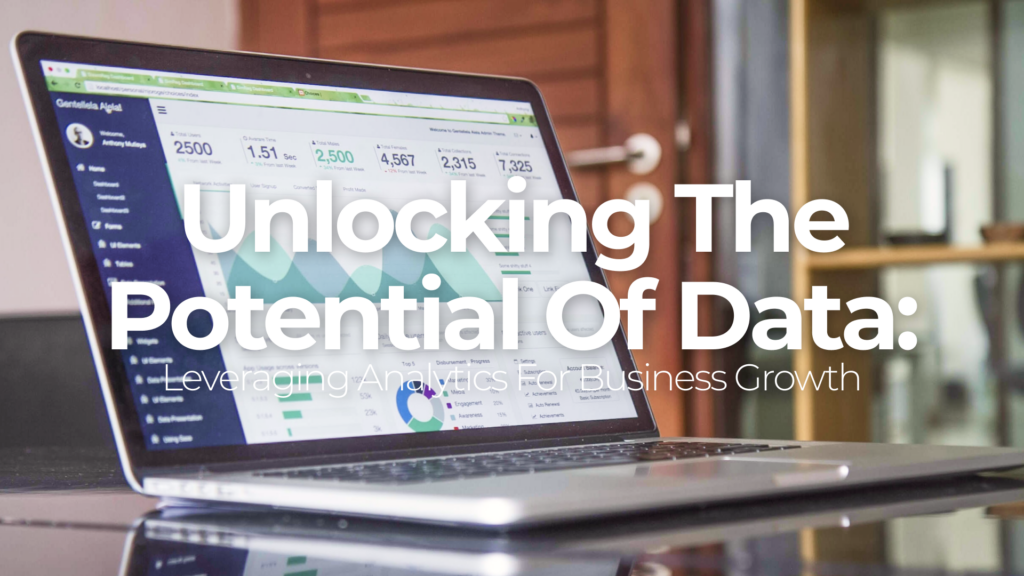Looking to learn more about business growth analytics? Well, you’re in the right place. Data has quickly become the lifeblood of business. The ability to extract valuable insights from data is what sets successful businesses apart from the rest.
Data analytics has emerged as a powerful tool, enabling businesses to uncover patterns, trends, and correlations within vast amounts of information. By unlocking the potential of data, you can gain a competitive edge, drive innovation, and make informed decisions that propel you towards success.
Throughout this blog, we’ll explore how businesses can leverage analytics to fuel their growth strategies. From understanding the different types of data analytics to building a strong data foundation, we will delve into the fundamental concepts that lay the groundwork for effective analysis. Furthermore, we will dive into the key analytics techniques and advanced technologies that drive business growth, showcasing real-world success stories along the way.
So, whether you are a seasoned data enthusiast or new to the world of analytics, join us as we unlock the potential of data and embark on a journey of leveraging analytics for business growth.
Understanding the Power of Data Analytics
Data analytics is a game-changer for businesses in the digital age, offering unparalleled opportunities for growth and success. At its core, data analytics refers to the process of extracting valuable insights and patterns from vast amounts of data. By harnessing the power of data analytics, you can gain a deeper understanding of your customers, optimise operations, and make informed decisions that drive tangible results.
There are several types of data analytics that provide different levels of insights:
Descriptive analytics: focuses on summarising historical data to understand what has happened in the past.
Diagnostic analytics: goes a step further by examining data to determine why certain events occurred.
Predictive analytics: utilises statistical models and algorithms to forecast future outcomes.
Prescriptive analytics: takes the analysis even further by providing recommendations and strategies for optimal decision-making.
The transformative potential of data analytics can be observed across industries. For example, retail companies leverage analytics to understand consumer buying patterns and personalise marketing campaigns. Healthcare organisations use data analytics to improve patient outcomes and identify high-risk individuals. Financial institutions rely on analytics to detect fraudulent activities and manage risk effectively.
By embracing data analytics, businesses can uncover hidden opportunities, identify potential risks, and gain a competitive advantage. The ability to make data-driven decisions empowers businesses to optimise their operations, improve customer experiences, and drive innovation. In an era where data is abundant, understanding the power of data analytics is crucial for businesses that aspire to thrive in the dynamic and ever-evolving marketplace.
Building a Strong Data Foundation
To effectively leverage data analytics for business growth, it is essential to lay a strong foundation. Building a robust data foundation involves collecting, organising, and managing relevant data in a structured and efficient manner.
The first step is to ensure the collection of high-quality data. This entails identifying the key data points that align with your business objectives and establishing mechanisms to gather accurate and reliable information. Whether it’s through customer interactions, online transactions, or IoT devices, collecting data from various sources helps paint a comprehensive picture of your operations and customer behaviour.
Next, organising the collected data is crucial for efficient analysis. Implementing data governance practices ensures that data is properly classified, standardised, and documented. This ensures consistency and reliability across the business, enabling easy access and interpretation of data by analysts and decision-makers.
Utilising data management tools and technologies is another critical aspect of building a strong data foundation. From data warehouses and data lakes to cloud-based solutions, there are various platforms available to store, process, and analyse large volumes of data. These technologies provide scalability, security, and accessibility, enabling you to handle the ever-growing demands of data analytics.
By building a strong data foundation, businesses can unlock the full potential of their data. It allows for comprehensive and accurate analysis, leading to actionable insights that drive business growth. Furthermore, a well-structured data foundation facilitates data integration, enabling different departments and systems to collaborate and share information seamlessly.
In conclusion, building a strong data foundation sets the stage for effective data analytics. It ensures the availability of high-quality data, enables efficient organisation and management, and leverages the right tools and technologies. With a solid data foundation in place, businesses can confidently embark on their analytics journey, knowing that they have the necessary infrastructure to extract valuable insights and drive sustainable growth.
Harnessing the Potential of Analytics for Business Growth
To leverage analytics effectively for business growth, businesses need to identify their key goals and objectives. Firstly, it’s crucial to define clear business goals that align with the overall strategy. Whether it’s increasing sales, optimising operational efficiency, or improving customer satisfaction – setting specific, measurable, attainable, relevant, and time-bound (SMART) goals provides a clear direction for analytics efforts.
Once the goals are established, you can apply analytics to gain actionable insights. This involves analysing historical and real-time data to identify patterns, trends, and correlations. By utilising statistical models, machine learning algorithms, and visualisation techniques, businesses can uncover valuable information that drives informed decision-making.
Analytics becomes a strategic asset when it is embedded into the decision-making processes. By incorporating insights from analytics into the strategy formulation, businesses can make data-driven decisions that have a tangible impact on growth. This could include optimising marketing campaigns based on customer segmentation analysis, identifying cost-saving opportunities through supply chain analytics, or personalising product recommendations using predictive analytics. Furthermore, you can leverage analytics to continuously monitor and evaluate the effectiveness of their strategies and initiatives. Regularly reviewing performance metrics, conducting A/B testing, and implementing feedback loops based on analytics insights allows for agile decision-making and course correction when necessary.
Harnessing the potential of analytics for business growth requires a combination of technology, expertise, and a culture that values data-driven insights. It is an ongoing journey that requires you to adapt to changing business landscapes and evolving analytics capabilities. By embracing analytics as a strategic enabler, businesses can unlock new opportunities, optimise their operations, and gain a competitive edge in today’s data-rich world.
Key Analytics Techniques for Business Growth
Analytics encompasses a wide range of techniques that can drive business growth and provide a competitive advantage. Let’s explore some key analytics techniques that you can leverage to unlock growth potential.
Exploratory Data Analysis and Visualisation: This technique involves examining data to uncover patterns, relationships, and anomalies. By using visualisations such as charts, graphs, and dashboards, businesses can gain a comprehensive understanding of their data and identify insights that can fuel growth strategies.
Customer Segmentation and Targeting: By segmenting customers based on attributes like demographics, behaviour, and preferences, businesses can personalise their marketing efforts, product offerings, and customer experiences. This targeted approach improves customer satisfaction, engagement, and loyalty, ultimately driving business growth.
Forecasting and Demand Planning: Analytics techniques such as time series analysis and predictive modelling enable businesses to forecast future demand, anticipate market trends, and optimise inventory levels. Accurate demand planning ensures that businesses can meet customer needs efficiently while minimising costs and maximising revenue.
Pricing Optimisation and Revenue Management: Analytics allows businesses to analyse market dynamics, competitor pricing, customer behaviour, and other factors to optimise pricing strategies. By setting optimal prices based on demand elasticity and value perception, businesses can maximise profitability and revenue growth.
Risk Analysis and Mitigation Strategies: Analytics helps businesses identify and assess potential risks, whether they are operational, financial, or reputational. By analysing historical data and employing predictive modelling, you can develop proactive risk mitigation strategies and enhance their resilience in a rapidly changing environment.
These key analytics techniques are not mutually exclusive but rather work together to provide a holistic approach to business growth. Combining these techniques with advanced analytics technologies, such as machine learning and artificial intelligence, empowers you to unlock valuable insights and make data-driven decisions that fuel their growth strategies.
Overcoming Challenges in Implementing Analytics for Growth
While the potential benefits of implementing analytics for business growth are vast, organisations often face challenges along the way. It is essential to address these challenges to ensure successful implementation and maximise the value derived from analytics.
One of the primary challenges is addressing data security and privacy concerns. With the increasing reliance on data, businesses must prioritise data protection to maintain customer trust and comply with regulations. Implementing robust security measures, data encryption, access controls, and privacy policies are critical to safeguard sensitive information.
Another common challenge is dealing with data silos and integration issues. Businesses may have data scattered across various systems and departments, making it challenging to derive comprehensive insights. By implementing data integration strategies and breaking down silos, businesses can create a unified view of their data, enabling better analysis and decision-making.
Overcoming resistance to change and fostering a data-driven culture is also crucial. Employees may be apprehensive about embracing analytics due to a fear of job displacement or a lack of understanding. To overcome this challenge, you should provide proper training and education on the benefits of analytics, encouraging a data-driven mindset and empowering employees to use analytics as a tool to enhance their work.
Furthermore, businesses must ensure that analytics initiatives are aligned with business objectives and have the necessary executive support. Lack of strategic alignment and buy-in from leadership can hinder the adoption and success of analytics initiatives. Clear communication, stakeholder engagement, and showcasing the value and impact of analytics can help overcome this challenge.
Conclusion
In conclusion, the potential of data analytics to drive business growth is immense. By leveraging analytics effectively, you can unlock valuable insights, optimise operations, and make informed decisions that propel them towards success.
As we have explored throughout this blog, understanding the power of data analytics and its various techniques is crucial for businesses to thrive. By embracing analytics, businesses can identify opportunities, personalise customer experiences, optimise pricing and demand planning, and mitigate risks effectively. Moreover, keeping up with future trends in data analytics, such as big data, real-time analytics, ethical considerations, augmented analytics, and IoT integration, will ensure businesses stay at the forefront of innovation and maintain a competitive advantage.
So, whether you’re a small startup or a multinational corporation, investing in data analytics capabilities and fostering a data-driven culture is key to unlocking the full potential of your business. Embrace the transformative power of data analytics, and embark on a journey of growth, innovation, and enhanced decision-making. Let data be your guiding light on the path to business success.
Here at Yo, we’re all about improving the success of the businesses we deal with. So, If you are interested in learning more about improving your business development, or generally future-proofing your business – enter your contact details into the form below and we’ll be in touch with how we can help you and your business TODAY!











